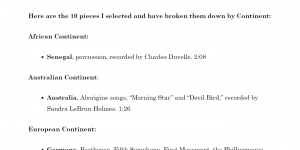I have connected my fifth Linking Post to the Golden Record activity which was Task #8. For this task we needed to listen to the music on the Golden Record and then narrow down the 27 pieces of music to just 10. I chose to link with Melissa Phillip’s post, as we both used the idea of selecting music from different continents along with a mixed genre.
My Link: https://blogs.ubc.ca/meipsyshack/2021/03/07/task-8-golden-record-curation/
Melissa’s Link:https://blogs.ubc.ca/melissaphillipstuckeretec540/2021/03/07/the-golden-record/
I found this to be a very interesting assignment. Like Melissa, I had only vaguely heard of the Voyager Golden Record, yet had never explored it further until this task. It is fascinating that this was created for the purpose of sharing who we are from Earth and compiling it into this Golden Record and then rocketing it off into outer space. I imagine Carl Sagan and his team must have had a lot of fun and engagement with this project. This is something I also noted while reading through Melissa’s post on the task. I liked how she shared her initial thoughts about the Voyager and states, “I love the fact that the scientists decided to include this account of life on Earth in the event that the Voyagers are found by extraterrestrial life forms.” This links in with some of my thoughts from my post referring to the Twenty Thousand Hertz (2019) podcast stating that it is, “A message to the cosmos. We are here and we are listening.” (31:22) or as quoted on the NASA website (n.d) by Carl Sagan, “The spacecraft will be encountered and the record played only if there are advanced space faring civilizations in interstellar space.”
As Melissa notes in her post, she considers what this project would look like if it were to be done and just how complex it would be to gather information to compile. I fully agree with how much more complex it would be as there are so many more voices, opinions and knowledge around the world to consider. Melissa draws from a quote by Rumsey (2017) that we are all “creatures” of the environment and culture that we grow up in, which is why we need to share the curation of our cultural memory (Brown University, 2017). This cultural memory would be so much more difficult to curate into a similar project today, as there is so much more to consider of what may be or not be considered relevant.
Looking closer at Melissa’s task, I noticed that she also chose her music first based on continent as she states, “My main criteria was that every continent where humans reside be represented,” as well as a blend of music types, which is how I also had broken down my choices. This is the reason that I initially chose to link with Melissa’s task as we have a similar overlap of ideas. As I looked closer to see just what songs she chose, I noted that out of the 10 song choices she had selected that we shared 6 of the same song choices. Of course that still shows the diversity in our own choices and what we finally considered to be selected. One difference I did note between the both of us was that Melissa provided a bit of a deeper reflection and further reasoning of why she chose her pieces under her categories, where I summed up my reasons in a different way. I like that she had added her thoughts on her choices as it provided a better insight into why she chose the songs, which then allowed me to understand who she is as a person as well. This brought me back to what I had mentioned in my own post, “Representation of information and the ways in which we collect that information has become more diverse and complex over the years. The way the text is portrayed on the Golden Record from the musical pieces to the symbols on the outside, shows the diversity of text technologies that are coming from Earth.”

Screenshot of Melissa’s layout

My screenshot showing the Continent layout
I navigated to Melissa’s blog site from the UBC link and was able to choose what task I wanted to look at before actually navigating to her site. Once there, I liked how she had her page set-up and that I found it to be bright and easy to read through. I liked the feature where as I scrolled down the page that the page would also scroll up, covering her border and giving the impression of a more interactive site. I also liked how we could easily leave comments at the end to share, as well as being able to go forward to the next post or backwards to the previous post. One thing I did notice that seemed to be a barrier was that there was not a menu at the top that could take me to her other posted tasks or even to her main homepage. The only way I could navigate to those areas was if I went back to the UBC main student blog site and click on her tasks from there or just simply keep following the forward or backward links at the bottom of her page. Having a main menu link to her tasks would be beneficial in being able to view her tasks and her interactions with the course content in an easier way. Overall, other than that barrier, the initial page I was on was a great first glance at getting to know Melissa through this task.
References:
Brown University. (2017, July 11). Abby Smith Rumsey: “Digital memory: What can we afford to lose?” [Video]. YouTube. https://www.youtube.com/watch?v=FBrahqg9ZMc
McDonald, L. (2019). Twenty Thousand Hertz, #65 Voyager Golden Record. Retrieved from https://www.20k.org/episodes/voyagergoldenrecord
NASA. (n.d) Voyager-The Golden Record. https://voyager.jpl.nasa.gov/golden-record/